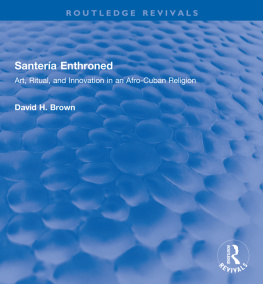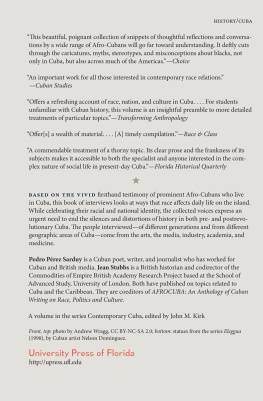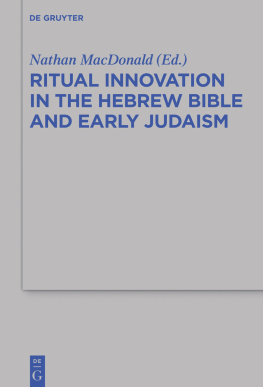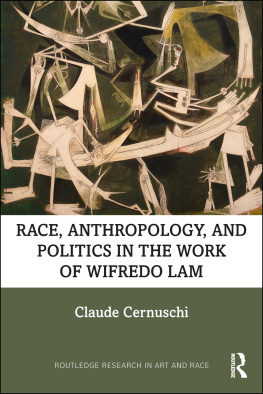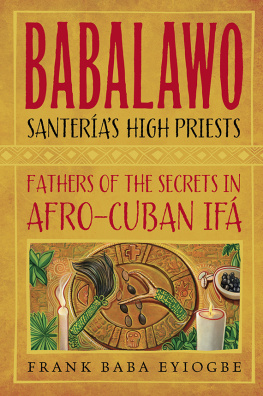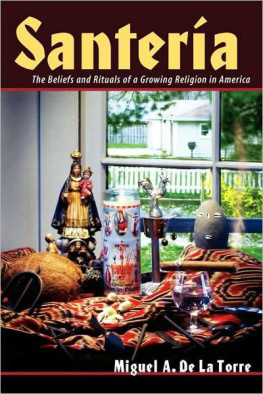ACKNOWLEDGMENTS
Un solo palo no hace monte.
[One stick does not a forest make.]
Afro-Cuban proverb
I have received invaluable moral and material support from numerous individuals and institutions during the researching and writing of this book, for which I am extremely grateful. A predoctoral grant from the Wenner Gren Foundation for Anthropological Research (1987) supported fieldwork in New Jersey, New York, and Miami. A Charlotte Newcombe Fellowship (Woodrow Wilson Fellowship Foundation) funded my dissertation writing (199798) and significant parts of the Ph.D. work appear, in revised form, in this book. A Smithsonian postdoctoral fellowship at the Center for Folklife Studies (1989) permitted theoretical refinements that contributed to the book manuscript. University Research Committee grants from Emory University (fall and summer 1992) provided me with course reductions to begin writing the book manuscript. I am very grateful to the American Council of Learned Societies (ACLS) for a postdoctoral fellowship to complete the first draft of the manuscript (199495). As the Rutgers Center for Historical Analysis Black Atlantic Project Senior Fellow for 199798, I was able to further develop theoretical and historical perspectives on the Black Atlantic. Finally, I am grateful to the W. E. B. Du Bois Institute for Afro-American Research of Harvard University for encouraging my continued investigation by having me as a nonresident fellow (19982003).
Special gratitude goes out to Dr. Francis and Mrs. Patricia Keneally for their generous subvention to support the publication of the color photographs.
I am grateful to my dissertation readers, Jean Christophe Agnew and John Szwed, and to my dissertation adviser, Robert Farris Thompson, who introduced me to the Black Atlantic world in his lectures and seminars at Yale University (198386). My research on Afro-Cuban religions had its genesis in Professor Thompsons spring 1983 graduate seminar entitled Face of the Gods: Shrines and Altars of the Yoruba.
I remain indebted to many colleagues, friends, students, and assistants who responded generously with their feedback, resources, and moral support. I would like to thank (in alphabetical order) Roland Abiodun, Michael Afolayan Oladejo, Andrew Apter, Brian Austin, Jacqueline Bamitz, Marc Bauerlein, Edna Bay, Julio Benitez, Jr., Herman Bennett, Ellie Berkowitz, Judith Bettelheim, George Brandon, Karen McCarthy Brown, Barbara Browning, Olivia Cadaval, Stefania Capone, Isabel Castellanos, Tom Concordia, Donald Cosentino, Pedro Csme Baos, Joanne Crudgington, Clodimir da Silva, C. Daniel Dawson, Antonio de Armas, Gustavo de Armas, Lauren Derby, David Dorris, Henry Drewal, Christopher Dunn, Angela Economy, Brent Hayes Edwards, Robin Evanchuck, Arlys Evans, Antonio Eligio Tonel Fernandez, Elizabeth Fenn, Ariel Fernandez, Pilar Fernandez, Ruddy Fernandez, Ysamur Flores-Pea, Jacqueline Frands, Pamela Franco, Lisa Freiman, Phyllis Galembo, Henry Louis Gates, Jr., Judith Gleason, Salvador Gonzalez Escalona, Marc Gottleib, Kenneth Haltman, Linda Henderson, E. Jane de Hohenstein, John Homiak, Marylin Houlberg, John Howett, Jean Howson, Alice Jarrard, Sidney Kasfir, Naomi Katz, Elliot Klein, Franklin Knight, Rebekka Kuntschik, Babatunde Lawal, Cynthia Liesenfeld, Julie Levin Caro, Mara Teresa Linares, Natacha Lourdes Lpez Grant, Rafael L. Lpez Valdes, Tom Lyman, Ibrahim Maller, Kristin Mann, Morton Marks, Elizabeth Marzloff, James Lorand Matory, Elizabeth McAlister, Sara McPhee, James Meyer, Claudia Mola Fernandez, Robin Moore, Beatriz Morales, Concepcion Morales, Gerardo Mosquera, Joseph Murphy, Babatunde Nasiru, Ester Nicle, Robert Orsi, Luis Alberto Pedroso, Balentino Prez, Clark Poling, Richard Powell, Richard Price, Jane Rehl, Elisha Renne, Natalia Revuelta Fernandez, Cabelo Rolim, Norge Romero Cordis, Zaid Romero Cordis, Lisa Mara Salb, Hdimo Santana, Michael P. Smith, Theophus Smith, Debra Spitulnik, Nicolas Spitzer, Jessica Taplin, Krista Thompson, Terri-Dawn Trosclair, Carmen Trujillo Pardo, Nong Tumsutipong, John Vlach, Derrick Williams, Jim Wafer, Patsy White, Katya Wilson, and Peter Wood.
I am grateful to the following people for their support in the preparation of the manuscript and illustrations and the production of this book: T. David Brent, Elizabeth Branch Dyson, Amy Collins, Perry Cartwright, Jennifer Gowins, Mike Brehm, Erik Carlson, Catherine Beebe, and Monica Holliday at the University of Chicago Press; Katherine Hagedorn and Grisel Lozano Garcini for their editorial and proofreading assistance; Isabel Castellanos, Executor of the Estate of Lydia Cabrera; and Mara Fernanda Ortiz Herrera, Representative of the Successors of Fernando Ortiz.
I would like to thank the following Cuban institutions: El Museo Polivalente de Regia, La Casa de frica, El Museo de la Msica, El Conjunto Folklrico Nacional de Cuba, El Grupo Afro-Cuba de Matanzas, El Museo Etnogrfico de Guanabacoa, La Biblioteca Nacional, El Museo Nacional de Bellas Artes, La Parroquia de Regia, La Parrquia de Guanabacoa, El Cementerio de Regia, El Cementerio de Coln, Juego Eforitong, Los Hijos de San Lzaro, La Comisin Organizadora de la Letra del Ao, La Sociedad El Cristo, La Sociedad San Roque, La Sociedad Santa Brbara, La Sociedad de San Antonio, El Cabildo Arar Sabal Nonj, El Cabildo de Santa Teresa, and El Cabildo de Fermina Gmez.
Still, neither my research nor writing could have been accomplished without the coauthors of this work, my most patient teachers and families of the Regia de Ocha, If, Arar, Abaku, and Palo: Perico Abasonga, Pedro Abreu, Roberto Almeida, Mara Eugenia lvarez Prez, Concha Angulo, Graciela Arandia, Francisco Aristola, Juan Arrencivia, Emilio Barreto, Luis Bauz, Reinaldo Blay (Ibae), Francisco Lalo Cabrera, Frank Cabrera Suarez, Olga Calvo Pig, Elpidio Crdenas, Idalberto Crdenas, Osvaldo Crdenas Villamil, Melba Carillo, Luis Castillo, Papo Reinaldo Raimundo Chaguayceda, Rosario Chinique, Nelson and Pedro Collazo, Mercedes Cordis, Radams Corona, Candelaria Cruz, Lzaro Cuesta Valds, Jorge Daz, Alejandro Dominguez, Mercedes Durn, Manuel Erize, Ramn Esquivel Bolaos (Ibae), Eusebia Febles, Juanito Febles, Adolfo Fernndez (Ibae), Raquel Fernndez, Juan Gallo, Josefina Garca, Zoraida Garca, Eddy Guilarte, Cosme Guio (Ibae), Juan Gutirrez Boza (Ibae), Ramiro Hernndez Almirall (Ibae), Gilberto Herrera Rojas, Zenaida Justz, Andrs Kol, Lourdes Lpez, Franky Malab (Ibae), Lzaro Marqueti, Raymond Mazzero, Mercedes Melo Gonzlez, Inocencia Mola, Fernando Zacara Molina Puente (Ibae), William Muldro (Sim-El Fatunmishe), Ricardo Navarro, Nenas Botnica, Anna Ortiz, Salvador Ortiz, Jr., ngel Padrn, Pedro Emilio Prez Martn, Fernando Pichardo, Nydia Pichardo, Carmen Pl, Gualberta Pig, Jos Manuel Pulido, Librada Quesada Mazorra (Ibae), Miguel Willie Ramos, Rosamara Roberts, Oscar Rodrguez, Pete Rodriguez (Ibae), Sandra Rodrguez, Gloria Rolando, Fredesvinda Rosell, Lzaro Ros, Antonio Sevilla, Chiqui Sevilla, Pablo Sevilla, Mara Sirgelina Martnez, Ernesto Valds Janet, Hermes Valera Ramrez, Jess Varona Puente, Margarita Ugarte (Ibae), Francisco Veitia, Ana Vidal, Roberto Villanueva, the Villalonga family, lberto Villar-real, and Francisco Minini Zamora Chirino.
I am especially grateful to Michael Atwood Mason, Katherine Hagedorn, Stephan Palmi, Ernesto Pichardo, Andrew Apter, Judith Bettelheim, J. Lorarul Matory, and Antonio Martn de Armas Arredondo, who remained steady and powerful interlocutors, critics, contributors of resources, and friends during the process of this works research and writing.
APPENDIX 1
REDRIKA BREMERS DESCRIPTION OF A SUNDAY AFTERNOON DRUMMING IN A HAVANA LUCUM CALBILDO, 1853
I. [On her arrival in the extramuros to visit an event in the Luccomes cabildo]
As these clubs generally meet in the afternoons and evenings of the Sunday, we set off in the afternoon to the street in which the

